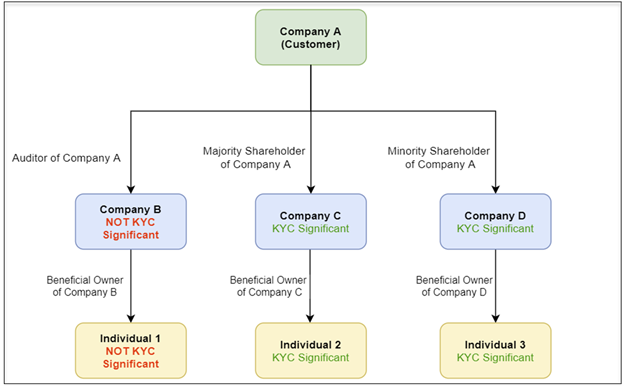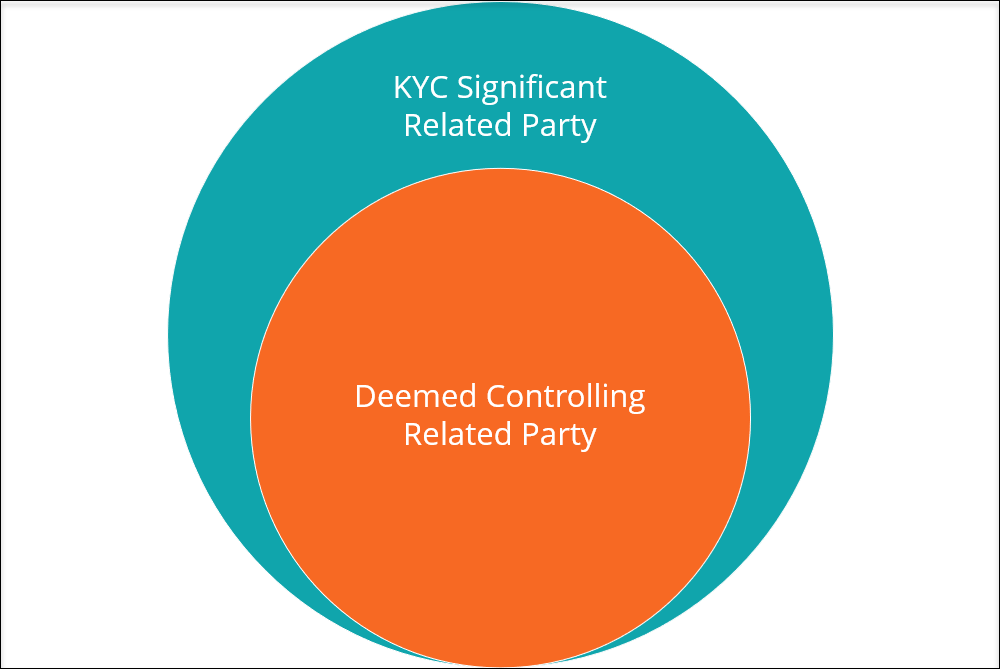
KYC and the Related Party model
With the Pega Client Lifecycle Management (CLM) and KYC application, your financial institution can capture related party information about a customer, including underlying beneficial owners and controlling persons. Obtaining this information, along with identification and verification of these parties, is one of the key tenets of the know your customer (KYC) process. Failing to collect, examine, and maintain the related party data of the customer can expose the financial institution to regulatory risks and substantial fines.
Customers who are not directly involved in illicit activities might be related through third-party individuals or organizations who participate in such activities. For example, the controlling parties, such as a beneficial owner above a certain ownership percentage, might be associated with other illicit organizations or found on an Anti-Money Laundering (AML) watchlist. These beneficial owners or, in general, controlling roles might knowingly attempt to use the products and services of the financial institutions for nefarious purposes.
Relationship components
To establish a relationship in Pega CLM, you identify the following components:
- Contracting party (customer): This component represents the individual or organization that you onboard or maintain in the system. The actual customer engages in a business relationship with the financial institution.
- Related party: This component represents the individual or organization that is associated with the contracting party. However, a related party can, in turn, be a contracting party in the context of other business relationships with the financial institution. For example, engaging as a Fund Manager.
- Roles in the context of the relationship: There are different roles that related parties can play in the context of the contracting party. For example, a related party can be an authorized contact, a legal representative, and a majority shareholder of a company which is the customer of a bank. Additionally, roles may have attributes such as the percentage of shareholder ownership. Commonly known role attributes are dynamically presented on the screen as roles are added to related parties.
Direction of relationships
As a KYC analyst, you research the customer through reputable sources to identify the relationship components. Once you satisfy the requirements of the components, the next step is to understand the direction of the related party relationship.
In general, you focus on related parties that are considered controlling or have significant ownership of a given company. Those parties play specific roles with the contracting party. These relationships are IS relationships. The parties use the following naming convention to establish the relationships:
<Related Party> is <Role> of <Contracting Party>
For example, Remote Enterprises, Inc. is Majority Shareholder of Couch Potato Technologies, LLC.
Additionally, you might want to understand the role that the contracting party plays in other parties. For example, a given contracting party might act as a subsidiary of another organization. These relationships are HAS relationships and use the following naming convention to establish the relationships:
<Related Party> has <Contracting Party> as <Role>
For example, Remote Enterprises, Inc. has Couch Potato Technologies, LLC as Subsidiary.
Roles and attributes
Pega CLM and KYC users who are responsible for collecting related party data can qualify some roles using commonly known attributes. For example, when capturing the shareholder of a given organization, you also capture the associated percentage of ownership. That percentage of ownership determines the level of due diligence profiling.
The input of all roles and attributes regarding related parties helps drive the due diligence necessary for them as well as for the customer they are associated to. When dealing with organizations, this work builds up the hierarchy structure of the contracting party.
Direct and indirect parties
Customers can have relationships with dozens of other parties either directly or indirectly through some of their direct related parties. For example, Organization A can be owned by Organization B, which is owned by Organization C. In this case, there are direct relationships between A and B and B and C. Organization B acts as an intermediate between A and C, which establishes an indirect relationship between the two organizations.
Having a complete account of direct and indirect parties is essential to give a comprehensive view of the organizations and understand their corporate and operational structures.
KYC significant parties
A large company that you onboard might have a complex network of dozens of related parties. The relevant related parties of a customer, also known as KYC significant, are parties that require some level of due diligence. This classification helps financial institutions determine where to focus time and resources when onboarding an organization. As a result, financial institutions operate more effectively while understanding and mitigating risk. Based on business rules, the Pega CLM and KYC™ application can automatically flag-related parties as KYC significant. Parties flagged as KYC-significant by the application undergo screening at a minimum and will require further due diligence if a positive screening match is found.
With the Pega CLM and KYC™, you articulate this process by creating separate Global KYC (GKYC) cases for each of the related parties that are flagged as KYC significant. Those GKYC cases, in turn, use eScreening cases (CSC) which are used to review and address any matches returned from screening providers. Any final due diligence is displayed as subsequent steps within the GKYC case.
For relevant training materials, see Client Due diligence module.
The application uses business rules to determine which parties are flagged KYC significant. The role and the associated attributes (for example, percentage of ownership) of the party determine whether it is deemed as KYC significant. Indirect related parties are flagged as KYC significant only if the party that is closest in proximity to the contracting party is KYC significant and the indirectly related party has a role that is deemed as KYC significant. The following figure shows this concept:
The implementation team of the financial institution can configure the business logic to determine if a related party is KYC significant by following the compliance policy.
Deemed controlling parties
The Pega CLM and KYC TM application flags related parties as Deemed controlling, which has a controlling role in the bank 'customer's organization.”. The application can determine this based on configurable business rules. The Deemed controlling flag of a party can be overridden directly on the UI as appropriate.
The application flags related parties as Deemed controlling; these related partiesare a subset of the KYC significant parties. All parties that are Deemed controlling are also flagged as KYC Significant. However, not all KYC significant parties are Deemed controlling.
The following figure illustrates this concept by showing the orange Deemed controlling Related Party circle inside the larger KYC Significant Related Party circle:
Reciprocal relationships
Reciprocal relationships exist in the context of related parties, and a few examples of these pairings are provided out of the box.
For example, Cookie Corporation is the majority shareholder of Biscuits Limited, which means that Biscuits Limited is a subsidiary of Cookie Corporation. In this example, Biscuits Limited is the customer, and Cookie Corporation is the related party that is connected by a majority shareholder role.
The Pega CLM and KYC™ application has a business rule stating that a party that is a Subsidiary always have a Majority Shareholder party associated with it. The application automatically adds the reciprocal leg of a relationship pair if the known role is in the application.
This Topic is available in the following Module:
If you are having problems with your training, please review the Pega Academy Support FAQs.
Want to help us improve this content?

